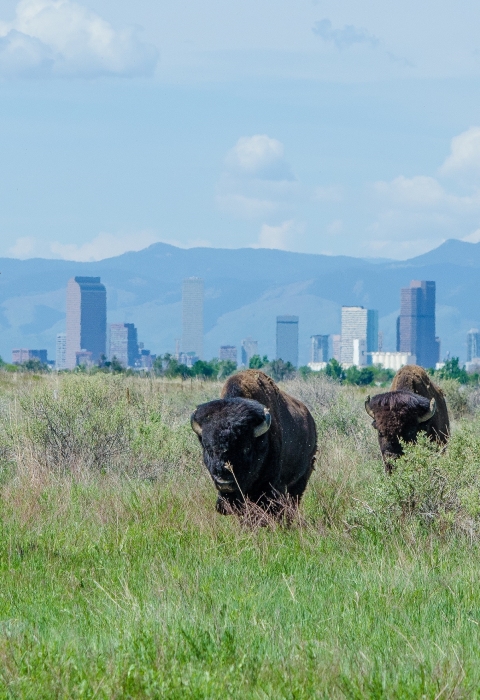Facility Rules and Policies
Visitor safety and wildlife conservation are top priorities at the Colorado Front Range National Wildlife Refuge Complex. At times, sections of the Refuges may be closed on short notice due to wildlife needs, weather, or special projects. The Refuges are subject to federal, state, and local laws and regulations.
To help make your visit safe and enjoyable, read the Refuge Rules and Regulations below for details about permitted and prohibited activities. You can also call the Visitor Center at 303-289-0930 (open Wednesday through Sunday from 9 am - 4 pm), and monitor the website for current hours of operation and alerts before visiting. We hope you enjoy your visit to the Refuge!
Designated trails, roads, and parking areas are open to public access from sunrise to sunset seven days a week and the Refuge is open most federal holidays (closed on Thanksgiving, Christmas, and New Year’s Day, and closed at 12:30 pm on Christmas Eve and New Year's Eve). The Visitor Center is open Wednesdays - Sundays from 9:00 am to 4:00 pm (closed on all federal holidays).
To protect wildlife and habitat, visitor access is limited to designated trails and roads only. All other Refuge lands and staff roads are closed to visitor entry.
Please Enjoy these Wildlife Related Recreational Activities In Designated Areas:
- Wildlife observation.
- Wildlife photography.
- Hiking on designated trails.
- Cross country skiing / snowshoeing on designated trails.
- Bicycling and Class 1 e-Bikes on designated trails.
- Bicycling and Class 1, 2 and 3 e-Bikes on designated roads.
- Seasonal catch and release fishing is permitted in accordance with state and Refuge regulations in designated areas. A Colorado fishing or small game combination license is required for all anglers 16 years and older who are fishing, and a daily fee is required.
- Archery (bow and arrow ONLY) permitted in designated area.
Prohibited activities and uses include, but are not limited to:
- Hiking and biking off designated roads and trails.
- Motorized vehicles off designated roads.
- Pets and other domestic animals (dogs, cats, horses, etc.).
- Parking in undesignated areas and overnight parking.
- Abandonment of wild or domestic animals.
- Launching, landing, and operating aircraft (model aircraft and unmanned aerial vehicles / drones).
- Possessing and discharging fireworks.
- Hunting.
- Discharging of firearms or other weapons.
- Disturbing, injuring, and damaging wildlife and plants.
- Searching for and removal of any object (plants, wildlife, natural objects, mineral, antiquities, etc.).
- Possession or consumption of alcoholic beverages.
- Possession or consumption of marijuana and any illegally controlled substance and associated paraphernalia.
- Commercial photography and motion pictures.
- Camping, tents, and building of structures.
- Abandonment of personal property and littering / dumping.
- Use of boats, canoes, kayaks, float tubes, paddleboards, and other floatation devices on Refuge waters.
- Walking or skating on ice.
- Swimming, wading, and bathing in all Refuge waters.
- Campfires and grills.
For additional information call the Refuge Visitor Center at 303-289-0930
To Report Violations on Federal Refuge Lands: dial 1-844-397-8477 or email FWS_TIPS@fws.gov
To Report Emergency / Medical / Fire: dial 911
Why Are Dogs Prohibited at Rocky Mountain Arsenal National Wildlife Refuge?
Dogs (pets) are not allowed at Rocky Mountain Arsenal National Wildlife Refuge, Two Ponds National Wildlife Refuge, and Rocky Flats National Wildlife Refuge. Bringing your dog to a national wildlife refuge national wildlife refuge
A national wildlife refuge is typically a contiguous area of land and water managed by the U.S. Fish and Wildlife Service for the conservation and, where appropriate, restoration of fish, wildlife and plant resources and their habitats for the benefit of present and future generations of Americans.
Learn more about national wildlife refuge can be very disruptive to wildlife and some visitors.
Many wildlife species perceive dogs (pets) as a predator and in some instances as prey to larger predatory species. Dogs (pets) can chase wildlife or be a visual threat to wildlife and birds, causing wildlife and birds to flee nesting, burrowing, feeding, and resting sites. The lingering scent of the dog (pet) can signal the presence of a predator, long after the dog (pet) is gone. The disturbance of wildlife burns much needed energy that animals need to survive and raise their young.
Dogs (pets) can carry disease into the Refuge’s wildlife populations. Dogs could unknowingly carry canine distemper, which can be detrimental to the health of our endangered black-footed ferrets and other small mammals. Dogs bark and disturb the quiet of the Refuge. Unfamiliar sights, sounds, and smells can disturb even the calmest, friendliest, and best-trained dog, causing them to behave unpredictably or bark excessively.
Dogs and other pets brought to the Refuge for a drive on the auto tour route must remain inside the vehicle while on the Refuge and should not be allowed to disturb or harass wildlife.
Service Animals
Service animals are allowed, but must be on leash control at all times. The definition of a service animal is any animal that is individually trained to do work or perform tasks for the benefit of an individual with a disability. The crime deterrence effects of an animal’s presence and the provision of emotional support, well-being, comfort, or companionship do not constitute work or tasks for the purposes of this definition.
Emotional support, therapy, or comfort animals do not qualify or meet the definition of a service animal under the Americans with Disabilities Act (ADA). For more information on service animals please refer to the Department of Justice Civil Rights Division’s “Frequently Asked Questions about Service Animals and the ADA” pdf file
Since I Can’t Bring My Pet to the Refuge, Where Else Can I Go?
As an alternative, visitors can walk dogs on leash along the Perimeter Trail, located just outside the Refuge boundary. The trailhead and parking are located just before the Refuge entrance on Gateway Road. It’s a great way to see Refuge wildlife, without impacting you, your dog, or the wildlife.
